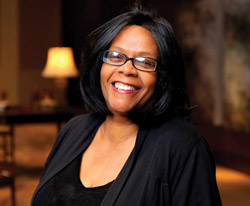Help Goes Corporate

Photo by Chris Hamilton
Interest in pro bono has surged recently at corporate law departments eager to establish their own legal volunteer legacies, and they’re looking to their experienced outside counsel to become active partners in the effort. Firms see pro bono as an opportunity for client development. And corporate counsel are eager to avail themselves of the typically greater resources available through the law firms to engage in volunteerism. The right collaboration can be gratifying for all sides, including those served.
“Corporate law departments are thirsty for pro bono projects because their lawyers want to give back, but they don’t want to do it themselves,” says Dorothy Jackson-Stallworth, Atlanta-based pro bono coordinator for Troutman Sanders. A pro bono partnership allows outside-firm lawyers to take the lead, which relieves the burden on the legal department.
Troutman Sanders hosts estate-planning training sessions for its in-house peers. Then once a week a team of two lawyers and one paralegal—staffed on a rotating basis by the firm and a variety of clients—drafts wills for firefighters, emergency personnel and terminally ill patients.
While joint pro bono projects can strengthen client connections and potentially lead to more client-driven work, firms must test the waters of each project so that when a client comes on board, the kinks have already been ironed out, Jackson-Stallworth advises. They should also evaluate the existing client relationship before undertaking a collaborative effort.
“Sometimes working together is better than a ballgame or golf. Putting heads together and doing something effective in the community builds trust, pride and caring between clients and lawyers,” says David Lash, managing counsel for pro bono and public interest services at O’Melveny & Myers in Los Angeles. However, he says, “you have to carefully assess the relationship between the firm and the client and craft something that fits in that relationship.”
For example, if an in-house lawyer drops the ball or a legal department becomes too busy to complete a project, a law firm may find itself in the awkward position of picking up the slack, or even criticizing its own client.
“You don’t want to have to call your client and ask, ‘Where are those interrogatories?’ ” Lash says.
WORKING TOGETHER
At O’Melveny, the joint staffing of law clinics aligns the pro bono goals of outside and inside counsel without putting clients on the hook.
Whether traveling to the Gulf Coast to assist hurricane victims or advising in Holocaust reparation cases, the lawyers act as individual counsel, yet are still able to come together to fashion strategies for each other’s prospective clients.
Several other large and regional firms have also collaborated with clients to staff pro bono projects, including Vinson & Elkins, Baker & McKenzie and Seyfarth Shaw.
Seyfarth’s client Caterpillar proposed creating a joint pro bono opportunity. The result is a clinic organized by the Chicago-based Center for Disability and Elder Law to assist with end-of-life documents.
“You often work with people by phone or e-mail,” says Kathleen Horchler, a corporate counsel in Peoria, Ill.-based Caterpillar’s legal services division. “It’s nice to have the opportunity to meet with them in person and get to know them better in an atmosphere where neither of you are the client.”



